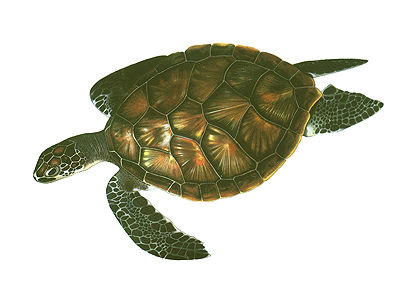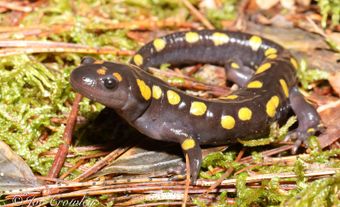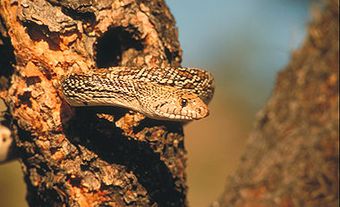Turtles are egg-laying, toothless reptiles with limb girdles roofed over by a wide rib cage and fused to bony plates in the skin. The outer skin covering consists of horny, epidermal scales of keratin (sulphur-containing, fibrous protein). The basic body plan of turtles - a 3-layered box of ribs, skin-bones and hornlike scales - has remained unchanged over 200 million years and, with minor modifications, has been adapted for life in oceans, rivers, lakes, bogs, forests, grasslands and deserts. There are some 285 species of turtle (order Testudines or Chelonia).
Distribution and Habitat
When Canada was ice covered and without reptiles, the greatest diversity of North American turtles was probably centered in the southeastern corner of the continent, where about 16 species occur today. After the Ice Ages, the major chelonian invasion of Canada was via the aquatic avenue of the Mississippi and Ohio rivers to southern Ontario. Subsequently a few species migrated into Québec and some even to chilly Nova Scotia. Others ventured westward but were deterred by the cold, dry Prairies. On both coasts, migration northward involved crossing many rivers; only one species of turtle spread northwestward to British Columbia and 4 species advanced eastward or northward to New Brunswick and Nova Scotia.
Over the past 3000-4000 years, a progressive, continental cooling has forced reptiles to move southward or become restricted to a single river valley, lake, bog or pond, where conditions suitable for survival still prevail. Thus, turtles have a tenuous toehold on the southern fringes of Canada, and locating these isolated pockets challenges both professional herpetologists and amateur naturalists.
Freshwater Species
The 8 native Canadian freshwater turtle species all occur in southern Ontario. In addition, 3 introduced species have been recorded. The 14 cm Pacific pond turtle (Actinemys marmorata), is limited to British Columbia and was probably introduced there. Another turtle in British Columbia is the western subspecies of the widespread painted turtle, the 23 cm western painted turtle (Chrysemys picta bellii), an invader from the Prairies. This subspecies ranges from British Columbia, across the southern Prairies and into western Ontario. The species is represented by the midland painted turtle (C. p. marginata) in southern Ontario and Québec, and by the 18 cm eastern painted turtle (C. p. picta) in New Brunswick and Nova Scotia. Most major categories of organism contain one or 2 species that can adapt to almost any natural or unnatural condition. Such is the painted turtle, a common sight basking on floating logs in many localities in southern Canada, except in turtleless Newfoundland and Prince Edward Island. The 43 cm snapping turtle (Chelydra serpentina) runs a close second, ranging from Saskatchewan to Nova Scotia. In contrast to the visible painted turtle, these species are secretive. However, they not only occupy every natural body of water from lake to marsh, snapping turtles even take over stagnant ditches, dams, fish ponds and farm water holes. These sinister, 18 kg monsters prey on anything, dead or alive. Their population densities can be astounding, as professional hunters have demonstrated; these big, muscular turtles are commercial restaurant fare. Introduced in southern British Columbia, Ontario and Québec is another basking turtle, the red-eared slider (Trachemys scripta elegans). Adults are the size of painted turtles but with a prominent red elongated spot on each side of the head, a greenish or dark upper shell, and yellow markings on the shell, limbs, tail and neck. It has been imported as hatchlings at various times in the pet trade. Well-meaning keepers have released individuals, which having survived to maturity in captivity had outgrown their aquaria. Out of their natural range in the United States, they may not successfully reproduce in Canada although they apparently occasionally successfully overwinter. They may carry diseases to native species.
The terrestrial eastern box turtle (Terrapene carolina carolina) and the semi-terrestrial wood turtle (Glyptemys insculpta) can be poisonous if they have recently fed on toxic mushrooms, and should not be eaten. In Canada reports of the 15 cm eastern box turtle are limited to southwestern Ontario, particularly Point Pelee, and southern Québec. These turtles are most likely escaped or released pets although some apparently suitable habitat exists. Shells turn up as ceremonial rattles in pre-European archeological sites but these were most likely brought north in tribal movements or trade from populations south of the Great Lakes.
The 20 cm wood turtle is a truly northern species, ranging from Lake Superior to Cape Breton Island. Haunting riverbanks, grassy meadows and floodplain forests, it is partial to wild berries and earthworms.
Painted turtles shed old scales as they grow. Wood turtles retain and add annual growth rings to each scale, and their age can be determined, much like that of a tree, by counting the rings. All but one of the remaining species are limited to extreme southern Ontario, with a few adjacent Québec records.
Turtles are best located through binoculars when they are basking or when just their heads project out of the water. The most distinctive head and neck is the 2-toned black (upper) and yellow (lower) of the 25 cm Blanding's turtle (Emydoidea blandingii). Partial to weedy bays, bogs and marshes, it eats fishes, tadpoles, insects and crayfish. East of the Ontario-Québec boundary, it is limited to a thriving, very isolated, relict population in southern Nova Scotia, centered in and adjacent to Kejimkujik National Park.
Two small turtles, the 10 cm "stinkpot" or musk (Sternotherus odoratus) and the 13 cm spotted turtle (Clemmys guttata), have a scattered distribution over southern Ontario and, in the latter case, southern Québec. Both are easily overlooked. The dark brown in colour musk turtle wanders about at the bottom of lakes, bogs and marsh pools searching for live or decomposing animal matter. It rarely basks and consequently becomes covered in algae and is very inconspicuous. The spotted turtle is a gregarious basker in spring but extremely shy. It frequents areas of swampy grass in woodlands and pools in marshes and bogs.
In the Great Lakes and some of the rivers feeding them in southern Ontario, as well as the Ottawa, St Lawrence and Richelieu rivers in Québec, 2 large, rather specialized turtles occur, the 27 cm northern map turtle (Graptemys geographica) and the 54 cm eastern spiny softshell turtle (Apalone spinifera spinifera). The pattern of maplike lines on the shell accounts for the map turtle's name. It has powerful jaws for crushing clams and other small crustaceans.
The eastern spiny softshell turtle frequents soft bottom areas where, befitting its flatfish shape, it lies in wait, half buried, ready to strike out at fishes and crayfish. It has the typical bony casement, but the outer skin is a thick, rubbery pancake extending beyond the flattened body. Nostrils are peculiarly extended into a long, tubular snorkel allowing the turtle to remain covered with sand or silt on the bottom yet reach the surface to breathe occasionally.
Marine Species
Five of the world's 7 species of sea turtles have been recorded in Canada, but these basically tropical and subtropical reptiles never nest on Canadian beaches. Green turtles (Chelonia mydas) have been occasionally recorded from both Atlantic and Pacific coastal waters of Canada and a few Atlantic loggerhead turtles (Caretta caretta) are reported off the East Coast. A hybrid between these species has also been reported off the East Coast.

Reports of the Atlantic ridley turtle (Lepidochelys kempii) are infrequent. The olive ridley turtle (L. olivacea) has been recorded off Oregon and Alaska and doubtless occurs occasionally in Canadian waters off British Columbia. Of an entirely different nature are regular reports of leatherback turtles (Dermochelys coriacea) near the Haida Gwaii and Vancouver Island, along Labrador and Newfoundland coasts, and tangled in fishing nets off the Maritime Provinces.
One of the largest living reptiles, the leatherback turtle is nearly 2.5 m from snout to tail and sometimes weighs over 550 kg. In summer, it regularly haunts the cold Atlantic and Pacific coasts of Canada (also Scotland, Norway, Alaska and Russia) hunting for its favourite food - giant lion's mane jellyfish. That it has a body temperature near 28ºC (18º above the surrounding seawater) was discovered in Halifax in 1971. The leatherlike, oil-saturated, thick (5-7 cm) skin provides a sort of blubber layer that retains heat generated by muscular contractions.

 Share on Facebook
Share on Facebook Share on X
Share on X Share by Email
Share by Email Share on Google Classroom
Share on Google Classroom








